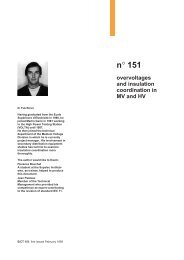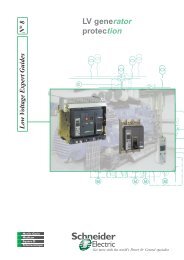sepam 20 user manual - Schneider Electric
sepam 20 user manual - Schneider Electric
sepam 20 user manual - Schneider Electric
You also want an ePaper? Increase the reach of your titles
YUMPU automatically turns print PDFs into web optimized ePapers that Google loves.
4<br />
Control and monitoring<br />
functions<br />
4/16<br />
Self-tests and fail-safe position<br />
Presentation<br />
The reliability of a device is the property that allows its <strong>user</strong>s to have well-placed<br />
confidence in the service it delivers.<br />
For a Sepam protection relay, operational reliability consists of ensuring the safety<br />
and availability of the installation. This means avoiding the following 2 situations:<br />
b Nuisance tripping of the protection<br />
Continuity of the electrical power supply is as vital for a manufacturer as it is for an<br />
electricity distribution company. Nuisance tripping caused by the protection can<br />
result in considerable financial losses. This situation affects the availability of the<br />
installation.<br />
b Failure of the protection to trip<br />
The consequences of a fault that is not eliminated can be catastrophic. For safety of<br />
operation, the protection relay must detect faults in the power supply as quickly as<br />
possible, using discrimination. This situation affects the safety of the installation.<br />
Self-tests and monitoring functions<br />
On initialization and cyclically during operation, Sepam runs a series of self-tests.<br />
These self-tests are designed to detect any failure in its internal and external circuits<br />
so as to ensure Sepam's reliability. These failures are classified into 2 categories,<br />
major failures and minor failures:<br />
b A major failure reaches the hardware resources used by the protection functions<br />
(program memory and analog input for example).<br />
This type of failure risks resulting in failure to trip on a fault or nuisance tripping. In<br />
this case, Sepam must go into the fail-safe position as quickly as possible.<br />
b A minor failure affects Sepam's peripheral functions (display, communication).<br />
This type of failure does not prevent Sepam from protecting the installation and<br />
providing continuity of service. Sepam then operates in downgraded mode.<br />
The classification of failures into 2 categories improves both safety and availability of<br />
the installation.<br />
The possibility of a Sepam major failure must be taken into account when selecting<br />
the trip command type to maximize availability or safety of the installation (see<br />
“Selecting the trip command and examples of use” page 4/19).<br />
In addition to the self-tests, the <strong>user</strong> can activate the trip circuit and closing circuit<br />
supervision function to improve the installation monitoring.<br />
This function sends an alarm message to the Sepam display unit and a data item is<br />
automatically available to the communication to alert the <strong>user</strong>.<br />
PCRED301005EN - 06/<strong>20</strong>08

















